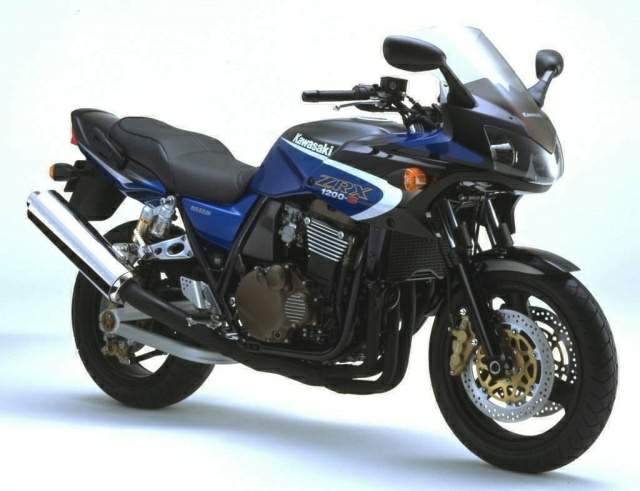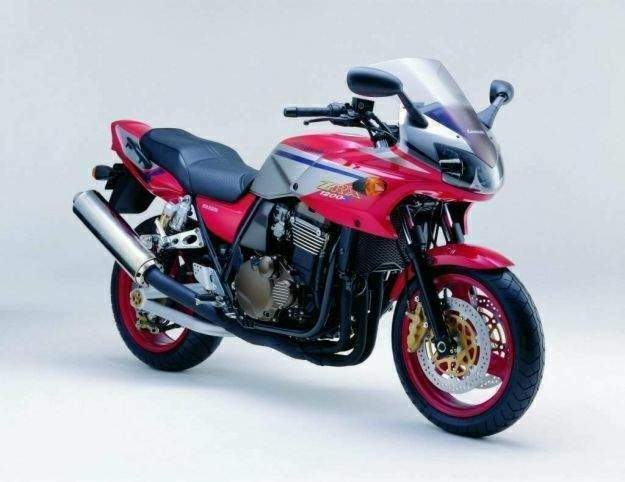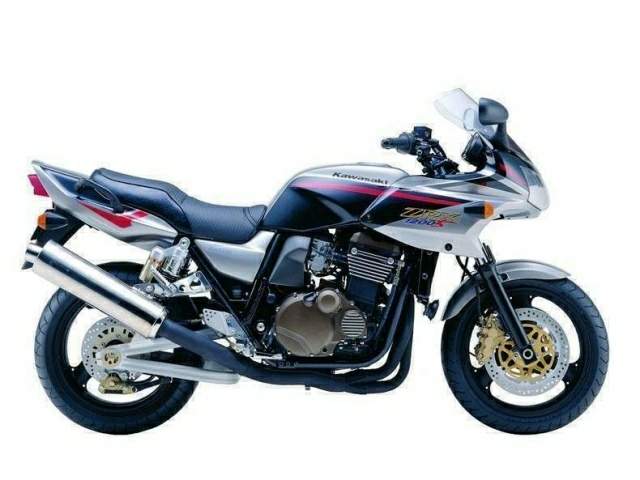
|
|
|
|
|
|
Classic Bikes
Custom Bikes
Individual
Racing Bikes AJP
AJS
Aprilia
Ariel
Avinton / Wakan
Bajaj
Benelli
Beta
Bimota
BMW
Brough Superior
BRP Cam-Am
BSA
Buell / EBR
Bultaco
Cagiva
Campagna
CCM
CF Moto
Combat Motors
Derbi
Deus
Ducati
Excelsior
GASGAS
Ghezzi Brian
Gilera
GIMA
Harley Davidson
Hero
Highland
Honda
Horex
Husaberg
Husqvarna
Hyosung
Indian
Jawa
Kawasaki
KTM
KYMCO
Laverda
Lazareth
Magni
Maico
Mash
Matchless
Mondial
Moto Guzzi
Moto Morini
MV Agusta
MZ / MuZ
NCR
Norton
NSU
Paton
Peugeot
Piaggio
Revival Cycles
Roland Sands
Royal Enfield
Sachs
Sherco
Sunbeam
Suzuki
SWM
SYM
Triumph
TVS
Ural
Velocette
Vespa
Victory
Vincent
VOR
Voxan
Vyrus
Walt Siegl
Walz
Wrenchmonkees
Wunderlich
XTR / Radical
Yamaha
Zero
Video
Technical
Complete Manufacturer List
|
Kawasaki ZRX 1200
|
| . |
|
Make Model |
Kawasaki ZRX 1200 |
|
Year |
2001 - 03 |
|
Engine |
Four stroke, transverse four cylinder, DOHC, 4 valves per cylinder. |
|
Capacity |
1165 cc / 71.0 cu-in |
| Bore x Stroke | 79 x 59.4 mm. |
| Cooling System | Liquid cooled |
| Compression Ratio | 10.1:1 |
|
Induction |
4x Keihin CVK36 carburetors |
|
Ignition |
Digital with K-TRICK |
| Starting | Electric |
|
Max Power |
122 hp / 88.9 kW @ 8500 rpm |
|
Max Torque |
112 Nm / 82.6 lb-ft @ 7000 rpm |
|
Transmission |
5 Speed |
| Final Drive | Chain |
|
Front Suspension |
43 mm fully adjustable, conventional cartridge-type fork, offers 12-way compression and rebound damping adjustment as well as fork spring preload |
|
Rear Suspension |
Fully adjustable rear shock |
|
Front Brakes |
2x 310mm discs 6 piston calipers |
|
Rear Brakes |
Single 250mm disc 2 piston caliper |
|
Front Tyre |
120/70 ZR17 |
|
Rear Tyre |
180/55 ZR17 |
| Wheelbase | 1465 mm / 57.7 in |
| Seat Height | 790 mm / 31.1 in |
|
Dry Weight |
227 kg / 500.4 lbs |
|
Fuel Capacity |
19 Litres / 5.0 US gal |
|
Consumption Average |
17.6 km/lit |
|
Standing ¼ Mile |
10.9 sec |
|
Top Speed |
246 km/h / 152.8 mph |
The Kawasaki ZRX1200R, a standard/naked motorcycle, was manufactured in Japan from 2001 until 2008. It is an evolution of the ZRX 1100, a stylized replica of the "Eddie Lawson Replica", a motorcycle made famous by the superbike racing champion of the same name.[1] With the ZRX1200R, Kawasaki's goal was to produce a motorcycle with the performance of a modern motorcycle, while retaining a design similar to the original Eddie Lawson Replica.
Worldwide, the ZRX 1200 was available in three guises: the ZRX1200S, which was partially faired; the ZRX1200R, which had a bikini fairing; and the ZRX1200N, which had no fairing. Unlike sport bikes, full handlebars made of tubular aluminum are utilized. For comfort, the saddle contains more than one centimeter of padding between the seat covering and the pan. Foot pegs are positioned similar to standard motorcycles, creating a seating position reminiscent of the classic Universal Japanese Motorcycle (UJM).
The frame is conventional steel tube with the engine supported in a removable cradle. The suspension configuration is similar to that found on a UJM. The lay-down rear shocks, designed with a built-in remote reservoir, are adjustable for preload and damping. The front suspension consists of conventional forks with adjustable damping and preload. The reinforced swing arm was designed to mimic the modified/aftermarket swingarms produced in the 1970s.
The bike features a liquid-cooled 1164cc inline 4-cylinder engine. Induction comes through four 36mm Keihin Constant Velocity carburetors. The exhaust system is a 4-into-1 stainless steel unit. The exhaust system on models produced up to 2004 are painted black, with the exception of the muffler, models produced from 2004-onwards are equipped with polished exhaust systems.

The ZRX1200S has been
deliberately built in the image of the bikes of the Seventies. It has four
cylinders, twin shock rear suspension and a big, ballsy engine that hangs out in
the breeze for all to see. The riding experience also owes a lot to the
Seventies 'universal Japanese Motorcycle' (UJM) that the big Zedder is so
blatantly modelled on.
For a start, you sit on the bike, rather than in it as with many of the modern
sports bikes. The bars are wide, fairly high and made of tubular steel, unlike
the stubby alloy clip-ons that grace so many bikes nowadays. It has a broad
saddle, built for comfort that actually contains more than 1mm of padding. The
footpegs aren’t placed in a cruiser position, but then they aren’t set too far
back and too high like on a hyper-sports machine. In other words, you’re now
sitting as you might have done when riding your CB750/Z900/GS750 all those years
ago.
Fire up the big ZZ-R1100 derived engine and you are greeted with a mechanical
rustle that's similar to a UJM from the Seventies, for despite the cunningly
disguised water cooling you actually know when the engine’s running. But click
the bike into gear, let out the clutch and twist the throttle and the first sign
that this is a modern and much-improved version of the UJM theme becomes
obvious. This bike is fast, effortlessly so, as you might expect from a bike
with an engine transplanted from the once-mighty ZZ-R1100. This is completely
different to the UJMs of the past that needed to be worked hard - they only gave
their best effort very near the red line. The ZRX1200 is different; in a word,
it’s got grunt.
Let’s pause for a little history lesson. In the seventies the engineers had
wrung every ounce of horsepower out of the air-cooled motors in an effort to
outdo the established bikes - mainly British twins based on very old designs -
and of course each other.
Kawasaki, Suzuki, Honda and Yamaha were at war in a big four-stroke battlefield.
It was a long-running battle to see who could make the fastest four-stroke
production motorcycle on the planet. In the early days, the laurels usually
rested with Kawasaki and the Z line up, often known in Britain as ‘Zeds’. The
range included the legendary Z900, the machine that aced even Honda’s CB750 way
back at the start of the Seventies. None of these ground-breaking Japanese bikes
actually contained anything new, the Italians had been making high-revving
inline fours for years, but only as race bikes.
What they did have was reliability, availability and a marketing machine like no
other that had gone before it. Honda and Kawasaki sold their big fours by the
truckload. But Suzuki, with the GS range of middleweight and big fours, nosed
ahead as the Seventies came to a close. It must have been galling for Kawasaki
that the very machines that were grabbing the horsepower headlines, and the
sales, were so blatantly modelled on their hugely successful Z range.
Enough history. Welcome back to the present day where the ZRX1200 could take on
and beat any of those old bikes - anywhere. Even suffering from the massive
burden of emission and noise regulations the latest incarnation of the Zed range
is much quicker than any of those old machines. It's especially quick where it
matters most - in the mid range. If you have anything more than 2,000 revs on
the tacho and take a big handful of throttle the bike hurtles forward like a
greyhound on amphetamines.
The surge of power keeps building all the way to the redline at 10,500rpm. The
big motor is so flexible, it allows you to be very lazy with the gearbox. Once
out of town, there's no need to use any other gear except top. Even in traffic,
I found myself leaving the ‘box in third and fourth - the motor will allow you
to take even the slowest corner in third, and yet it still provides smooth and
progressive drive out of the turn.
The only flaw in this user-friendly power package, at least on my test bike, was
a slight hesitation coming off idle. This carburretion glitch also made its
presence felt when shutting off suddenly from high speed. The engine felt like
it had gone into total shutdown when the throttle was snapped shut - twisting
open the throttle was sometimes met with an almost imperceptible delay before
the power surged in. I'm nit picking here, and the trait may have been peculiar
to the individual machine. The bike did pop and bang through the exhaust pipe
sometimes on overrun, possibly evidence of an air-leak somewhere in the
four-into-one system, which might have upset the carburretion.
Getting the mix of outright power with flexibility just right is a challenge to
the engineers in these days of stringent emission controls. The Kawasaki, with a
bank of four carburettors and a catalytic converter hidden in its end can does
an admirable job. But I'd like to have had the chance to ride another machine to
see if it carburetted the same as this particular test model.
I said earlier that the ZRX would beat its UJM ancestors hands down anywhere and
it definitely would in the twisties. The Japanese were so obsessed with making
their bikes fast in the Seventies that they forgot to make them go round
corners. In fact, they didn't actually know how to build a chassis capable of
handling the weight and power of their engines.
Even the legendary Honda racers had an reputation for evil handling and the
late, great Mike Hailwood reported that he would be in a bad mood for hours
after wrestling them around the GP circuits. The Japanese resorted to hiring
European experts from the very motorcycle companies they had helped to destroy
in an attempt to tame the wild handling of both their race bikes and the road
machines.
While the cycle parts might look superficially similar to those fitted to the
Seventies UJMs, the components on the ZXR are far more sophisticated. The laid
down rear shocks, with their piggy back remote reservoirs, are adjustable for
preload and damping and look the part. As does the massive reinforced swing arm,
which has been designed to mimic something a UJM owner might have fitted as an
aftermarket part in the Seventies.
Combined, the shocks and swinger do a good job of keeping the rear wheel planted
and delivering the 122bhp made by the mighty motor to the ground. Up front a
pair of right way up forks do their bit in keeping the ZXR stable. They're not
up to the same (very high) standard of the kit found on almost any modern
Superbike - so you can't take the sort of liberties that you might with
something like the GSX-R1000K.

The ZXR is relatively heavy at 227kgs and the wheelbase too long (1465mm) to
expect sportsbike-style razor sharp handling. But despite the conservative
steering geometry, and its weight, the ZRX can be made (should that be forced ?)
to turn in hard and it will hold its line. The handlebars are long enough to
provide plenty of leverage and direction changes feel relatively easy. But at
high speed, changing line mid corner requires the pilot to work hard to keep the
ZRX up with a well ridden hyper-sports bike.
The combination of well thought out suspension, plus the weight and wheelbase
conspire to shrug off most bumps. Really heavy going will induce a little
twitchiness from the front end. The rear isn't too happy with very bumpy going
either, and the stiffly damped rear shocks will keep your own rear end informed
of just how hard they are working.
But the chassis works well enough that, when combined with the brilliant engine,
the ZRX is perfectly capable of giving a few sports bike riders a surprise or
two. Power needs control and the six-pot front calipers grip a pair of tea tray
sized discs to keep things in check. The brakes are very strong but need a good
squeeze to get the best from them. They are a little wooden at lower speeds and
you have to work them hard when you really need them. But, given effort, you’ll
soon be lifting the rear wheel under heavy braking – and building up those
forearm muscles. The rear disc is brilliant; it’s powerful, yet controllable
too.
This bike is just so much fun that I started to take the piss. Spinning the rear
tyre at the lights, popping wheelies, stoppies and sliding the rear tyre on the
brakes when stopping in front of bemused schoolgirls. ( I thought that was your
normal riding style – Ed ) If you’ve got the heart you’ll have plenty of fun on
the big Zed.
The ZRX is available in three guises, the ZRX1200S, an ‘R’ version with a bikini
fairing that apes the original Z1100R, or the Eddy Lawson replica – so called
because the American racer used one to win Superbike races in the USA. There’s
also the standard unfaired model, the ZXR1200.
Your choice would depend on what you want from the bike. The ‘R’ model might be
the best for those seeking the authentic looks of a late Seventies muscle bike.
The naked version will suit those with strong necks, you’ll need one to hang on
to the 122bhp missile at 155mph!
The fairing on the ‘S’ isn’t faithful to the Seventies look, it’s far too sleek
and modern looking for that. But it does a brilliant job in keeping the rider
comfortable. The airspace behind the fairing is completely still, even at 100mph
plus cruising speeds. I’m six foot tall and usually find the turbulence from
this type of half-fairing knocks my head about more than five rounds with Mike
Tyson would. Not so on the ZRX, the air coming over the top of the screen was
steady at all speeds and the cockpit was a place of almost Buddhist tranquillity.
This, combined with the effortless power of the engine, could have got me into
big trouble! I often glanced down at the speedo on a motorway to find my
cruising speed had crept up to well over 100mph. Things were so quite and calm
that I honestly hadn’t realised I was riding so fast, officer.
The ZXR’s Seventies styling combined with 21st century technology won’t suit
everyone. Bikers are individuals and some will want a bike that’s even more
Retro and others will want something cutting edge. But the ZRX is such a capable
bike, and a damn fine looking one too, so it’s sure to find some takers. Those
riders that are easily seduced by good looks and fine figures combined with
mental horsepower won’t be disappointed with Kawasaki’s funky update of the
Seventies UJM.
Source insidebikes.com

|
Any corrections or more information on these motorcycles will be kindly appreciated. |